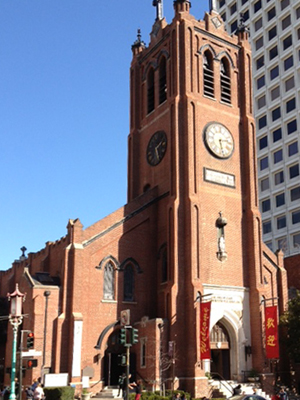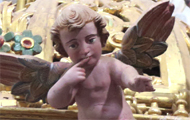| |
 |
 |
 |
| Comment on this report, or find other reports. |
 |
| Our Mystery Worshippers are volunteers who warm church pews for us around the world. If you'd like to become a Mystery Worshipper, start here. |
 |
| Find out how to reproduce this report in your church magazine or website. |
|
|
| 2493: Old Cathedral
of St Mary and Holy Family Mission, San Francisco, California,
USA |
 |

|
 |
Mystery
Worshipper: Galadriel.
The church:
Old Cathedral of St Mary of the Immaculate Conception and
Holy Family Chinese Mission, San Francisco, California, USA.
Denomination:
Roman Catholic,
Archdiocese
of San Francisco. The church is administered by the Missionary
Society of St Paul the Apostle, better known as the Paulist
Fathers.
The building:
A brick structure dating from 1854, serving as the seat of
the Archbishop of San Francisco until 1891. The building survived
the great earthquake of 1906, only to be completely gutted
the next day by the fire that ensued, which even melted the
church bells. It was restored in 1909. Inside it is wider
than it looks from outside. The high altar is marble, replacing
the original marble altar that was completely pulverized by
the fire. The reredos behind the altar is a triptych depicting
the Immaculate Conception, the Assumption, and what appears
to be St Michael casting Satan into hell.
The church:
This was the first church in the world to bear the title of
Immaculate Conception, which dogma Pope Pius IX had pronounced
only 17 days before the cathedral's dedication. A Chinese
mission was established here in 1903, and its successor, Holy
Family parish, is the only Catholic Chinese parish in San
Francisco. Old St Mary's promotes a wide range of social outreach
activities, such as a seniors grocery program, and offers
workshops in spirituality and Bible study. It is also linked
to a Catholic elementary school that offers an academic program,
value based education, computer learning, Mandarin classes,
an after school study and after school care program, athletics,
and other activities. Two masses are offered every day, with
three on special holy days.
The neighborhood:
The church, a historic landmark, is located at 660 California
Street at the intersection of Chinatown and the financial
district, near downtown San Francisco. When the cathedral
was first built, this neighborhood was known as the Barbary
Coast and bore a rather seedy reputation. A plaque underneath
the cathedral clock bears the inscription "Son, observe
the time and fly from evil" (Ecclesiasticus 4:23) and
was meant as a stern warning for men who frequented the surrounding
brothels.
The cast:
Celebrant: the Revd Terry Ryan, CSP, a visiting priest from
White Plains, New York. Also contributing were the welcomer,
Barbara Schmidt; an unnamed cantor and pianist; and assorted
lay persons.
The date & time:
First Sunday in Lent, February 17, 2013, 8.30am.
What was the name of
the service?
Mass.
How full was the building?
About 80 people were present. They were well spread out through
the church, so it looked fuller than it actually was.
Did anyone welcome you
personally?
I was welcomed with "Good morning and welcome to you."
I was then handed a worship booklet with all the hymns and
sung responses, and was advised that the water at the back
of the church was holy water, should I wish to use it. There
was a further welcome ritual at the beginning of the service
(see below).
Was your pew comfortable?
Traditional pews, wooden, firm and a little on the low side
but not uncomfortable. For kneeling there was a pull-down
kneeler, leather-padded, appropriate for purpose.
How would you describe
the pre-service atmosphere?
Quietly reverent. Immediately before the service the cantor
stepped forward and taught the congregation the sung response
for the psalm of the day.
What were the exact
opening words of the service?
"Good morning, everyone, and welcome to all of you."
This was followed by a tactful reminder to switch off phones
and electronic devices. Then the welcomer said that, since the
church gets many visitors, it is their custom to get people
to introduce themselves to their immediate neighbors. She introduced
herself and then invited us to shake hands all round our seats.
This did engender a cheerful spirit; everyone was smiling as
they did it.
What books did the congregation
use during the service?
All the words of the service, including hymns, were in the
service booklet handed out on arrival. Some of the music was
modern, but the Sanctus, Benedictus and Agnus Dei were all
based on ancient plainsong chants.
What musical instruments
were played?
Piano.
Did anything distract
you?
For the first part of the service I could not hear the celebrant.
If he had a microphone he was not using it. Having essentially
to struggle either to hear or to lip-read, I was not really
able to concentrate on spiritual matters.

Was the worship stiff-upper-lip,
happy clappy, or what?
Straightforward modern Roman Catholic mass. Nothing unusual.
It was quite brisk but did not feel rushed.
Exactly how long was
the sermon?
4 minutes.
On a scale of 1-10,
how good was the preacher?
8 – Very well crafted and clear of content, crisply delivered.
Fortunately by then he was using a microphone so I could hear
every word.
In a nutshell, what
was the sermon about?
When we think of vocation, we tend to think of something we
do well, which fits our skills. Thatís the secular vocation.
Spiritual vocation is the opposite. To be spiritually developed,
we need to be saying "no" sometimes. In the desert.
Jesus denied himself food, thus practicing saying "no"
to his human self so he could open himself saying "yes"
to Abba, his Father. For Lent we have to give up something,
the giving up of which changes us into someone more Christ-like.
Which part of the service
was like being in heaven?
The preaching.
And which part was like
being in... er... the other place?
The singing Ė very few people attempted to sing. The cantor
was fantastic, giving a really
clear lead, and all the music was in the booklet, but hardly
anyone joined in.
What happened when you
hung around after the service looking lost?
At the end of the mass, before the final blessing, the celebrant
invited everyone to coffee and gave very clear directions
how to find it after the service. At the back, people collecting
in books also offered encouragement to go for coffee.
How would you describe
the after-service coffee?
The coffee was served from a pump flask and was hot though
not very strong. Biscuits and cookies were also offered. Very
few members of the congregation attended, but those who did
were friendly.
How would you feel about
making this church your regular (where 10 = ecstatic, 0 =
terminal)?
6 – I love my music too much to enjoy worshipping regularly
in a church where people donít join in the hymns. However,
I would perhaps try the later Sunday morning mass first. Maybe
all the singers and keen musicians attend that one?
Did the service make
you feel glad to be a Christian?
Yes.
What one thing will
you remember about all this in seven days' time?
The cantorís effort to get the congregation to join in with
hymns and responses. His enthusiasm never flagged despite
getting so little response. And also the sermon; it was cogent
and memorable food for thought for the whole of Lent.
|
|
|
 |
 |
 |
| We rely on voluntary donations to stay online. If you're a regular visitor to Ship of Fools, please consider supporting us. |
 |
 |
 |
| The Mystery Pilgrim |
 |
| One of our most seasoned reporters makes the Camino pilgrimage to Santiago de Compostela in Spain. Read here. |
 |
 |
 |
| London churches |
 |
| Read reports from 70 London churches, visited by a small army of Mystery Worshippers on one single Sunday. Read here. |
| |
|
|
|
|


